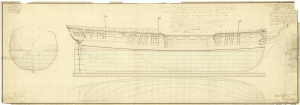HMS Diana (1794)
 Plan used for the Diana
| |
| History | |
|---|---|
| Name | HMS Diana |
| Ordered | 28 March 1793 |
| Builder | Randall & Brent, Rotherhithe |
| Laid down | March 1793 |
| Launched | 3 March 1794 |
| Completed | 6 June 1794 |
| Out of service | Sold to the Dutch Navy on 7 March 1815 |
| Honours and awards | Naval General Service Medal with clasp "Egypt"[1] |
| Name | Diana |
| Acquired | Bought from the British on 7 March 1815 |
| Fate | Destroyed in dry-dock accident on 16 January 1839 |
| General characteristics | |
| Type | 38-gun Artois-class fifth rate frigate |
| Tons burthen | 999 3⁄94 bm |
| Length |
|
| Beam | 39 ft 3+1⁄2 in (12.0 m) |
| Depth of hold | 13 ft 9 in (4.19 m) |
| Sail plan | Full-rigged ship |
| Complement | 270 (later 315) |
| Armament |
|
HMS Diana was a 38-gun Artois-class fifth rate frigate of the Royal Navy. She was launched in 1794.
Because Diana served in the Royal Navy's Egyptian campaign between 8 March 1801 and 2 September, her officers and crew qualified for the clasp "Egypt" to the Naval General Service Medal that the Admiralty authorized in 1850 to all surviving claimants.[Note 1]
Diana participated in an attack on a French frigate squadron anchored at Saint-Vaast-la-Hougue at the action of 15 November 1810, which ultimately led to the destruction of the . (Boats from Diana went in and set fire to the beached Eliza despite heavy fire from shore batteries and three nearby armed brigs; the British suffered no casualties.[3])
In January or February 1812 the French captured Patent, Gillespie, master. Diana recaptured Patent on 4 February.[4] Patent arrived at Plymouth on 6 February.[5]
Fate[]
On 7 March 1815 Diana was sold to the Dutch navy for £36,796. On 27 August 1816 she was one of six Dutch frigates that participated in the bombardment of Algiers. Diana was destroyed in a fire on 16 January 1839 while in dry-dock at Willemsoord, Den Helder.
Notes, citations, and references[]
Notes
Sources
- ^ "No. 21077". The London Gazette. 15 March 1850. pp. 791–792.
- ^ "No. 17915". The London Gazette. 3 April 1823. p. 633.
- ^ "No. 16438". The London Gazette. 25 December 1810. p. 2061.
- ^ "No. 16598". The London Gazette. 28 April 1812. p. 813.
- ^ "The Marine List". Lloyd's List. No. 4638. 11 February 1812. Retrieved 7 October 2020.
References
- Colledge, J. J.; Warlow, Ben (2006) [1969]. Ships of the Royal Navy: The Complete Record of all Fighting Ships of the Royal Navy (Rev. ed.). London: Chatham Publishing. ISBN 978-1-86176-281-8.
- Winfield, Rif (2007). British Warships in the Age of Sail 1794–1817: Design, Construction, Careers and Fates. Seaforth. ISBN 1-86176-246-1.
- HMS Diana at Modelships.de – ship model with a short description.
- HMS Diana at Jotika Ltd. – another model with additional info.
- Frigates of the Royal Navy
- Frigates of the Royal Netherlands Navy
- 1794 ships
- Ships built on the River Thames
- Maritime incidents in January 1839
- Artois-class frigates
- European naval ship stubs
- Dutch history stubs
- United Kingdom naval ship stubs